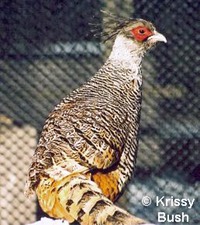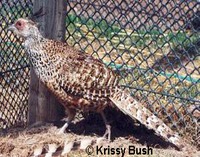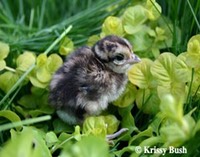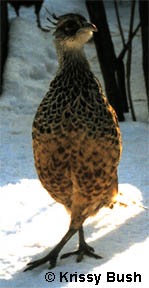Scientific Information
Class: Aves
Order: Galliformes
Family: Phasianidae
Subfamily: Phasianinae
Genus: Catreus
Species: Catreus wallichi
Species English name: Cheer Pheasant
CITES Status: CITIES I - endangered
Distribution: Himalayan mountain range - Afghanistan to Nepal
(from A Monograph of Pheasants Volumes I, II, III & IV, William Beebe)
Description
• Both sexes - cryptic colouration allowing them to blend in with their environment. Of the most intricately patterned Pheasant species.
• Male - Buffish-grey body colour with dark brownish-grey barring. Rusty-orange colour starting in wings and extending to rump. Creamy rusty-orange tail with brown barring. Red wattles. Dark grey head and crest. Greyish-ivory beak and legs.
• Female - Buffish-grey body colour with dark brownish-grey barring. Rusty-brown colour starting at the back and extending to rump. Creamy with brown barring. Red wattles. Dark grey cap and crest. Greyish-ivory beak and legs.
Diet
• We feed our breeders and young adults 16% layer pellets, our tiny chicks 25% Turkey Starter crumble, and our growing chicks 20% crumble.
• They get a handful of mixed grains every second day except during breeding season, fresh greens (lettuce, chickweed, dandelions, grass) and fruits (tomato, grapes, berries, etc.) when available.
• Cheer are big diggers and will eat grass, weeds, and insects.
Breeding
• Done in pairs (monogamous species).
• Cheer are first year birds.
• They start laying eggs mid- to late April and will lay every second day until they lay approximately 15 eggs.
• They lay a medium sized creamy egg with brownish to brownish-purple spots/blotches.
Incubation
• Eggs are collected twice a day and marked with the date and breeding pen number and set daily.
• Eggs are set in an automatic turning Lyons Roll-X (RX2) with grid 89.
• Temperature 99.8°F, humidity-wet bulb 82 with humidity adjusted periodically depending on development of the air space shown by candling
• On the final day of incubation, each egg is placed in its own oval wire mesh hatching basket (6" x 3" x 3") and set in the Sportsman Rattite hatcher.
• Incubation for Cheer is 26 days.
• After the chick hatches, it stays in the hatcher for a minimum of 8 hours.
Chicks
• Chicks are whitish-cream with black barring.
• They start out in our round 18" brooder pen with a mixed assortment of chicks. After a few days they are separated into a 2' x 4' baby pen for about a week. They are then transferred to a Cheer-Impeyan 2' x 6' pen for the next 7-9 weeks. They stay with this grouping until they go outside. All of these brooding pens have wire bottoms with a heat lamp at one end and feed & water at the other end. The heat lamp is attached to a dimmer switch so we can turn down the amount of heat as the chicks get older until it is turned off completely.
• After they are off of the heat for a few weeks, they are moved outside to the pheasant house (has outside grassy pens and a heated inside house part where they are blocked in for the night). At this point they are separated into an all Cheer pen. After they are toughened up, they are moved to an outside chick pen.
• Chicks are very easy to raise together with their own kind.
Pens
• 25' long x 10' wide x 6' high with a 4' x 4' x 4' house in the middle.
• Pens are covered with 2" diamond top-rite.
• Pens contain grass, which need to be re-seeded yearly because they are avid diggers. If you give them a large pen with well established grass, they will generally dig up all of the grass around the periphery, but will keep grass in the center of the pen.
• See Scintillating Copper Article for predator proofing set-up
Behavior
• Are calm and tame birds. The females like to make well formed deep nests. Both sexes like to dig and dust. They are easy to tame down and are a nice hardy bird.
• Both sexes make a loud shill alarm call when they feel threatened.
• Not a commonly kept Pheasant because the males are not brightly coloured, but are one of the most interesting and hardy Pheasant species.
Article By Krissy & Donna Bush
Pheasant Ridge



